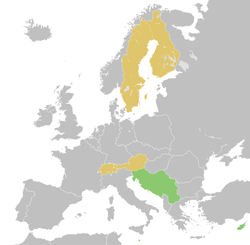Neutral and Non-Aligned European States
Neutral and Non-Aligned European States | |
|---|---|

Neutral and Non-Aligned European States | |
| Membership | |
| Area | |
• Total | 1,176,407 km2 (454,213 sq mi) |
| Population | |
• 1971 estimate | ~ 47,800,000 |
Neutral and Non-Aligned European States, sometimes known by abbreviation NN states,[1][2] was a Cold War era informal grouping of states in Europe which were neither part of NATO nor Warsaw Pact but were either neutral or members of the Non-Aligned Movement. The group brought together neutral countries of Austria, Finland, Sweden and Switzerland on one, and non-aligned SFR Yugoslavia, Cyprus and Malta on the other hand, all of which together shared interest in preservation of their independent non-bloc position with regard to NATO, European Community, Warsaw Pact and the Council for Mutual Economic Assistance.[3] Established and comparatively highly developed European neutral countries perceived cooperation with non-aligned countries (particularly with SFR Yugoslavia as one of the leaders of the group) as a way to advocate for peace, disarmament and superpowers' restraint more forcefully than their limited earlier cooperation would permit.[4]
The group cooperated within the Conference on Security and Co-operation in Europe (CSCE) in trying to preserve the results of the Helsinki Accords.[5] In this framework, Yugoslavia cooperated with Austria and Finland on mediation between blocs, organized a second CSCE summit in 1977 in Belgrade and proposed drafts on national minorities protection which are still valid and integral parts of OSCE provisions on minority rights.[6]
See also
[edit]- Declaration of Neutrality
- Finlandization
- Swedish neutrality
- Swiss neutrality
- Yugoslavia and the Non-Aligned Movement
- Cyprus and the Non-Aligned Movement
- Malta and the Non-Aligned Movement
- 1995 enlargement of the European Union
- 2004 enlargement of the European Union
- Neutral member states in the European Union
- Partnership for Peace
- European microstates
- Operation Gladio
References
[edit]- ^ Håkan Wiberg (1994). "Neutral and Non-Aligned States in Europe and NOD". In Bjorn Moller (ed.). Non-offensive Defence For The Twenty-first Century. Routledge. ISBN 9780429039300.
- ^ Tvrtko Jakovina (2011). Treća strana Hladnog rata. Fraktura. ISBN 978-953-266-203-0.
- ^ Fischer, Thomas; Aunesluoma, Juhana; Makko, Aryo (2016). "Neutrality and Nonalignment in World Politics during the Cold War". Journal of Cold War Studies. 18 (4): 4–11. doi:10.1162/JCWS_a_00677.
- ^ Hakovirta, Harto (1983). "Effects of Non-Alignment on Neutrality in Europe: An Analysis and Appraisal". Cooperation and Conflict. 18 (1): 57–75. doi:10.1177/001083678301800105. JSTOR 45083856.
- ^ Martinović, S. (1983). "Foreign Policy of Yugoslavia". Pakistan Horizon. 36 (1): 28–31. JSTOR 41394717.
- ^ Trültzsch, Arno. "An Almost Forgotten Legacy: Non-Aligned Yugoslavia in the United Nations and in the Making of Contemporary International Law".
Further reading
[edit]- Hanna Ojanen, ed. (2003). Neutrality and non-alignment in Europe today (PDF). Finnish Institute of International Affairs. ISBN 951-769-151-3.
- Mark Kramer; Aryo Makko; Peter Ruggenthaler, eds. (2021). The Soviet Union and Cold War Neutrality and Nonalignment in Europe. Lexington Books. ISBN 9781793631930.
- S. Victor Papacosma; Mark R. Rubin, eds. (1989). Europe's neutral and nonaligned states: between NATO and the Warsaw Pact. Wilmington. ISBN 0842022694.
External links
[edit] Media related to Neutral and Non-Aligned European States at Wikimedia Commons
Media related to Neutral and Non-Aligned European States at Wikimedia Commons
- Non-interventionism
- Foreign relations of Europe
- Political history of Austria
- Political history of Cyprus
- Political history of Finland
- Political history of Malta
- Political history of Sweden
- Political history of Switzerland
- Foreign relations of Yugoslavia
- Diplomatic umbrella groups
- Organization for Security and Co-operation in Europe







